Iowa is known for its lush fields and rolling hills, but did you know that the state is also home to an array of mushrooms? From morel mushrooms to blewits, Iowa’s mushroom population has grown over the past few years. With its variety of climates and soil types, Iowa is perfect for mushroom growing and foraging.
What are the common edible mushrooms of Iowa? Morels, golden oyster, dryad’s saddle, king boletes and chanterelles, there is something for every Iowan.
We’ll also explode common inedible fungi in the Hawkeye state. In this article we will explore all the different kinds of mushrooms you can find in Iowa with pictures for easy identification.
List of Edible Mushrooms in Iowa
1. Morels in Iowa
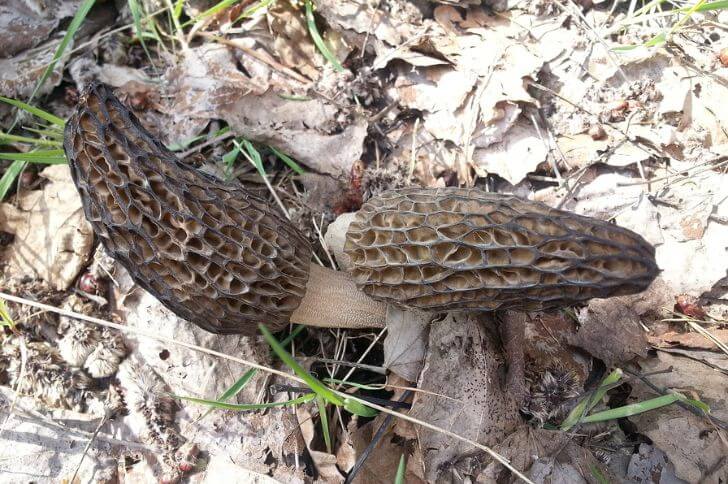
Let’s start with morels. They are common but hard to spot due to their color. If you are a first time forager, here is how to identify them.
Identification:
To identify morel mushrooms, start by looking at the shape of the cap. It should be deeply pitted and honeycomb-like with ridges that run lengthwise down the stem.
The cap should also be attached to the stem without any separation. Morels can range in color from yellowish-gray to brown but they all have a distinctive spongy texture when touched. In addition, when cut a true morel is hollow.
When can you find morels in Iowa? Start foraging in early spring after the first showers; April through May. You can find them around dead elms and they may reappear in the same spot the next year. They also grow near ash trees.
2. Golden Oyster Mushrooms
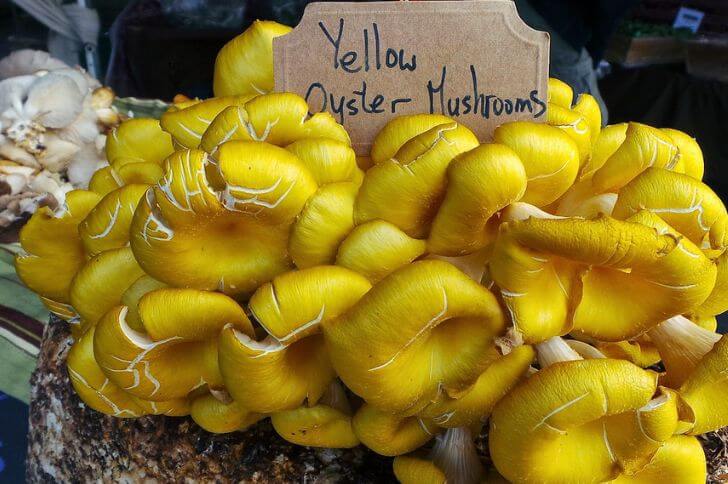
Golden oyster mushrooms, also called Pleurotus citrinopileatus, are one of the most common mushrooms of Iowa.
Identification:
There are three foolproof ways to identify golden oysters in the wild. One, check for their vibrant yellow-gold hue on the caps. The cap should be between 0.75-2.5 inches in diameter with thin flesh and a velvety surface.
Two, for mature mushrooms the middle of the cap is indented, giving it a funnel-like shape. Their color fades to almost white.
Three, check the stalk. Golden oysters have white stalks with wide spaced gills running down. Lastly, like other oysters they grow in tight clusters. What do golden oysters taste like? I find them nutty and sweet. I also really like their texture; it’s soft compared to the dryad’s saddle.
3. Dryad’s saddle
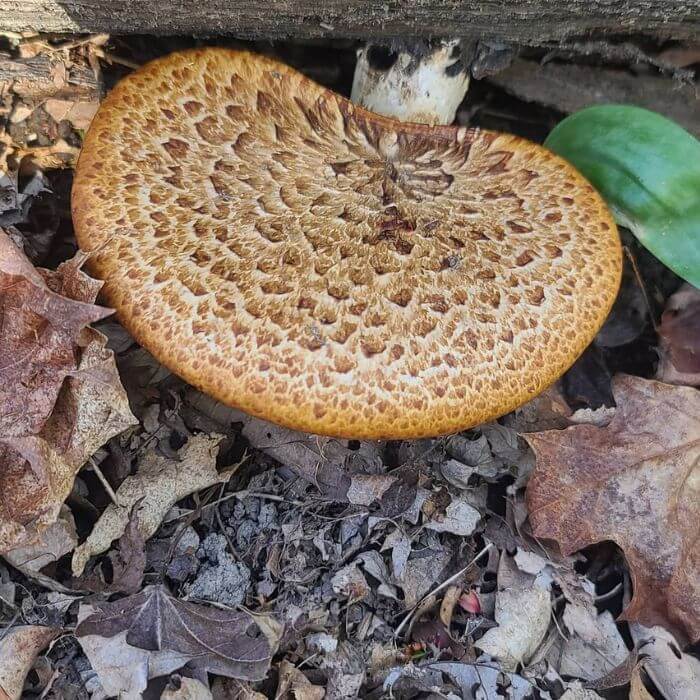
source: dictonova3
From April to May Dryad’s saddle occurs in abundance in Iowa. Renamed Cerioporus squamosus, this Iowa fungi has no true lookalikes, making identification easy.
Identification:
Its fruiting body is recognizable by its large size and fan-like shape which can range from 3 to 12 inches in size. Like most bracket fungi, the older the mushroom the tougher it is to eat. Pick younger species, so about 3-5 inches across.
The upper surface of the mushroom has a light brown in color with dark brown scales that are easily visible to the naked eye. The underside is whitish and contains large pores that release spores. When fresh, it has a soft texture but when dried out it will become hard like wood.
Also, check their thick stems that darken towards the base. These edible mushrooms grow on stumps of elms or silver maple. You can also find them on living willows, beech or ash trees.
4. Sulphur Shelf (Chicken of the Woods)
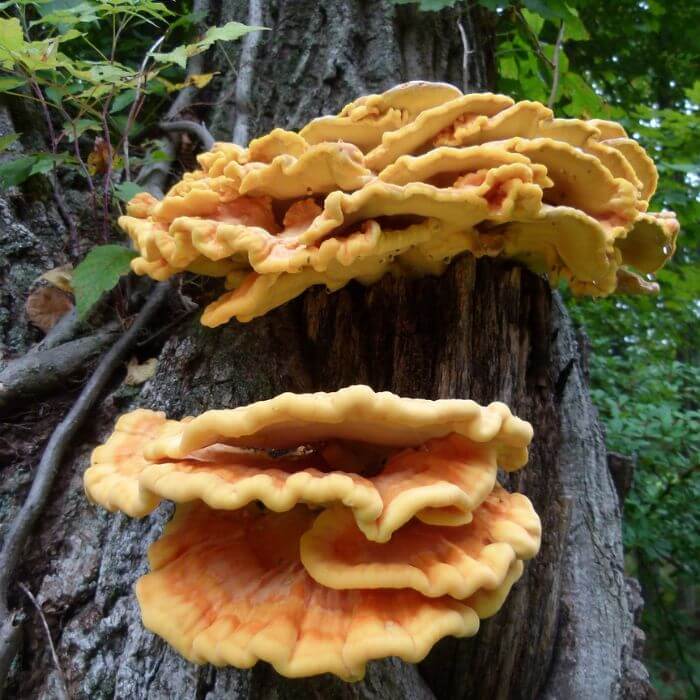
Sulfur shelf mushroom identification is important for anyone looking to gather these mushrooms. Also called the chicken of the woods, it’s one of the finest edible fall mushrooms in Iowa. .
Identification:
Chicken of the woods can range in color from yellow to orange and have a fan-like shape with thick flesh. Also, sulfur shelf mushrooms are characterized by their size which can reach up to fifteen inches wide when fully matured.
The top surface of the mushroom has many folds or wrinkles. Flip them and the underside has pores; chicken of the woods do not have gills.
Where can you find sulphur shelf mushrooms? You can find them at the base of dying oaks, conifers, willows, and sweet chestnut trees. When can you find chicken of the woods in Iowa? From June through to September.
5. Pearl Oyster Mushrooms
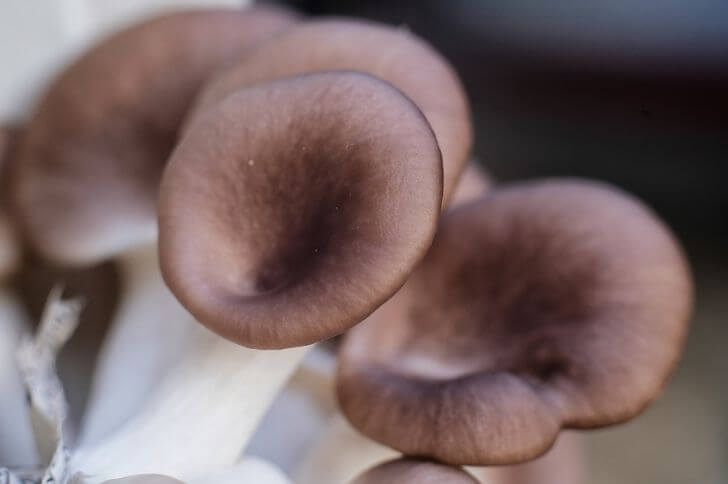
Mushroom foragers love oyster mushrooms. They’re easy to identify and make an excellent addition to meals, particularly when sauteed. Knowing how to spot oysters is a great skill for anyone looking to add them to their culinary repertoire.
Identification:
The most obvious identifier of oyster mushrooms is their shape and coloration. They tend to be fan-shaped with curved edges and range in color from greyish white all the way through shades of tan or brown.
Their texture is soft and velvety, not slimy like some other types of mushroom. The gills underneath should be close together and run down the stem. When can you find oysters in Iowa? Throughout the month of May.
6. Turkey Tail
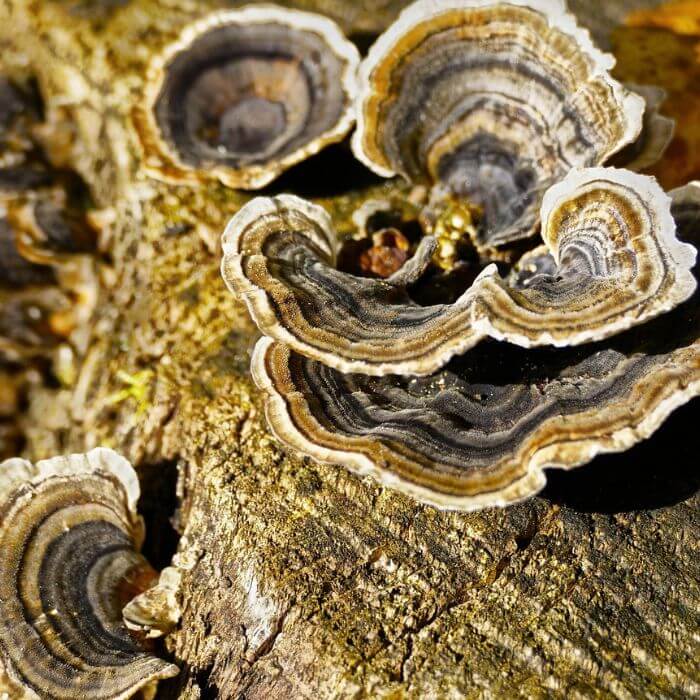
Identifying the turkey tail mushroom is an important part of foraging and eating wild mushrooms. This mushroom, also known as Trametes versicolor or Coriolus versicolor, is a common bracket fungus of Iowa
Identification:
It gets its name from its distinctive shape which resembles the feathers of a wild turkey’s tail.
The caps are typically one to four inches in diameter and have concentric rings of different hues that look like stripes. Also the caps have small hairs that make them feel and look velvety. Under the cap, turkey tails have pores.
Are turkey tails edible? No, though younger fungi are flexible they are not edible. But, you can grind and use in broths and teas.
Related Read: Learn about other tree mushrooms
7. Green Russula
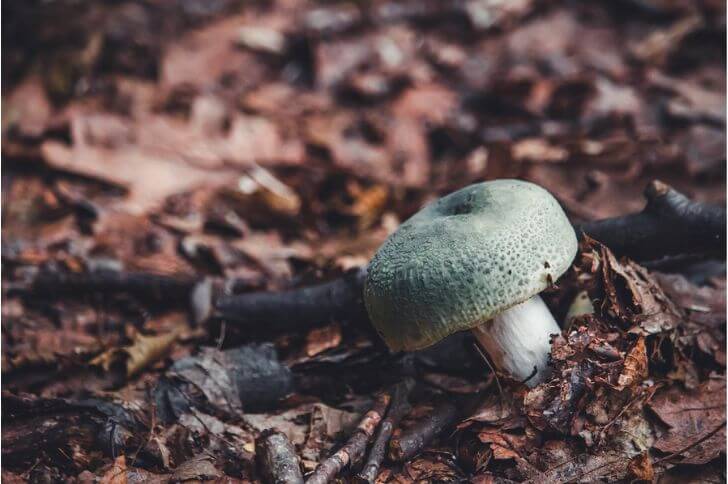
The russulaceae family comprises hundreds of mushrooms including brittlegills and waxcaps. These mushrooms are popular in Europe compared to North America, but once you’ve had a taste, you’ll look forward to the next mushroom season.
Identification:
You can easily pick them out because of their distinct shape, color and texture. These mushrooms have a greenish cap that is usually convex to almost flat in shape. The green edges are cracked, giving it its name cracking russula. The gills are white or off-white in color.
Note the thick white flesh. What does green russula taste like? They are nutty and sweet. You can find them from July through September.
8. Silky rosegill
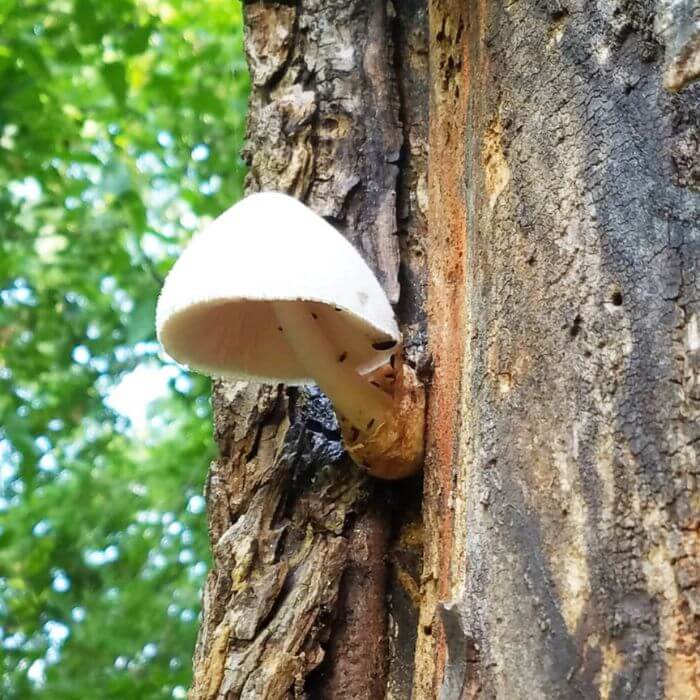
source: the.knowingnothing.explorist
Interesting and beautiful are two words I can use to describe the silky rosegill. This mushroom closely resembles the destroying angel, which is inedible. When foraging, here are telltale markers to help you identify silky rosegills.
Identification:
One, during the initial grow stages, silky rosegills have an egg-shaped fruiting body. During the next stage of growth they have bell-shaped fruiting bodies that grow to about 8 inches tall.
Two, the cap stem of this mushroom is covered with white fibrils, giving it a silky texture while the stem is white and smooth.
Three, they have a faint ‘mushroomy’ scent. Also they have a volva at the base of the stem.
You can find them growing on living elms or beech trees. Tare one of the rarest mushrooms of Iowa and unless you are an experienced forager, we recommend you avoid them since they have an exact look-alike, the destroying angel.
9. Chanterelles

Chanterelle mushrooms are a beloved edible fungus that can be found in Iowa from July to August. These small, golden-orange mushrooms have a distinctive look and flavor that makes them popular with chefs and foragers alike.
Identification:
Identifying chanterelles is not always easy, because of jack-o-lanterns which bear a close resemblance. Sure telltale chanterelle markers are:
Chanterelles have several defining characteristics that make them easily distinguishable. Generally, they are trumpet-shaped or funnel-shaped with blunt ridges or wrinkles on the caps.
The cap color ranges from egg yolk yellow to orange. The false gills on the underside of these mushrooms are generally forked. Note their ‘apricoty’ scent.
Also, these yellow-orange mushrooms always grow on the ground, usually around beech, oaks and pines.
10. Velvet Stem (Velvet Shank)
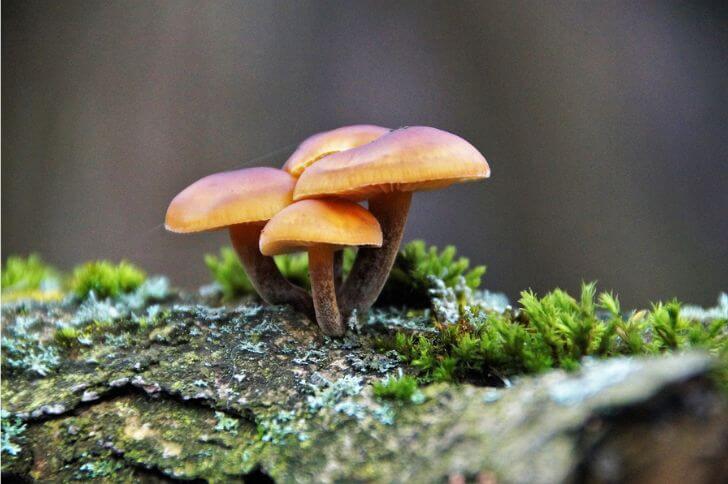
Flammulina velutipes, commonly known as the velvet stem or velvet shank, is another type of edible mushroom of Iowa. Most foragers like it for its unique flavor and texture
Identification:
Identifying velvet shank mushrooms can be easy when you know what to look for. The caps are typically 1-3 inches wide with a smooth surface. Caps are convex-shaped but appear distorted due to the crowding. Speaking of crowding, velvet shank mushrooms grow in tight clusters like honeys.
Additionally, the gills are whitish to pale yellow in color, slightly attached to the stem and very crowded.
They have an ‘orangy’ stem when young which turns yellow-brown as it ages. They have a white spore print. You can find flammulina velutipes in Iowa from August through November. I highly recommend you use this cluster mushroom to make soup.
11. Black-staining Polypore
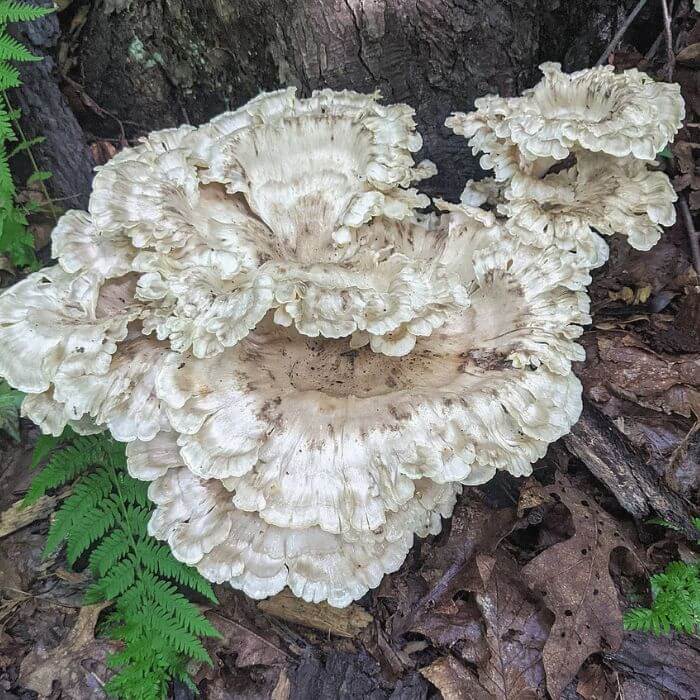
source:wildhighlandsnj
Black-staining polypore mushrooms, also called the giant polypore, are a misunderstood mushroom. They have a bad rep because they look like the ‘hen of the woods mushroom’ but are not as tasty. But, I’ve added them to this list because they are edible.
Identification:
When identifying any kind of mushroom it’s important to observe its features carefully, including the cap, stem, gills or pores and spores. Black-staining polypores have multiple caps that can grow up to 20 inches across.
Each spoon-shaped cap measures 2-8 inches across, has wrinkles and hairs. Another tell tale sign that you are looking at a black-staining polypore is the color of the caps.
Like other polypores, they come with zoned caps. Each zone has a distinct color ranging from white to brown to black. The edges are black, giving the mushroom its name.
Where can you find black-staining polypore? Like hen of the woods they are found around hardwood species. They have a pleasant taste when young. In Iowa, you hunt for this large fungus from early August to late September.
12. Giant Puffball
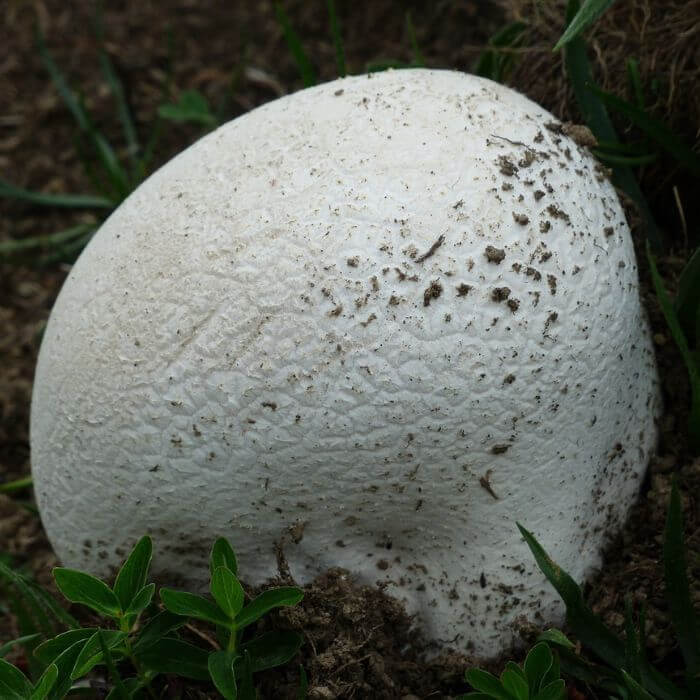
As an edible fungi, the Giant Puffball mushroom is a delicacy for mushroom enthusiasts. In Iowa it occurs from early August through September, so if you are looking for an edible fall mushroom, you can’t go wrong with this large white wild mushroom.
Identification:
This large variety of puffball mushrooms can be identified by its classic white exterior and round shape. Its size should not be underestimated as it can range anywhere from 8 inches to over 20 inches in diameter. Giant puffballs as large as 60 inches in diameter have been recorded.
The interior of the Giant Puffball mushroom is solid and white with a firm texture when young.
Once mature, this mushroom will become spongy like a marshmallow and release a strong odor.
As such, it is important to harvest this type of mushroom when young so that it retains its flavor and consistency. Furthermore, its taste is described as bland but earthy when cooked correctly!
13. Black Trumpet
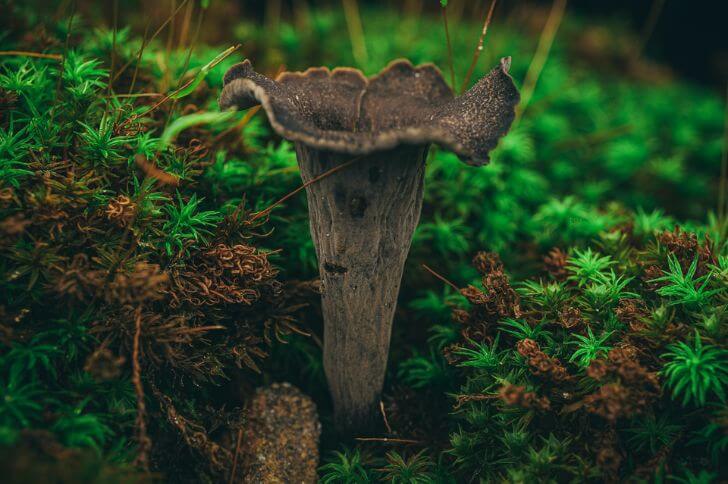
Are there black mushrooms in Iowa? Yes, black trumpet mushrooms are available throughout fall and here are its main markers.
Identification:
With its unmistakable shape, striking coloration, and robust flavor profile, it’s no surprise that these fungi have become some of the most sought-after mushrooms among amateur mycophiles.
The Black Trumpet mushroom is characterized by its distinctive funnel shape and dark gray-black coloration. It often grows in clusters near oak trees or other hardwoods and can reach heights of 4-6 inches tall when mature.
You can also find them near streams or mossy areas. These mushrooms are also quite fragile which makes them difficult to transport without damaging them. They don’t have gills. They belong to the chanterelle family.
Also read: Visiting the Big Island, check common mushrooms of Hawaii
14. Shaggy Mane
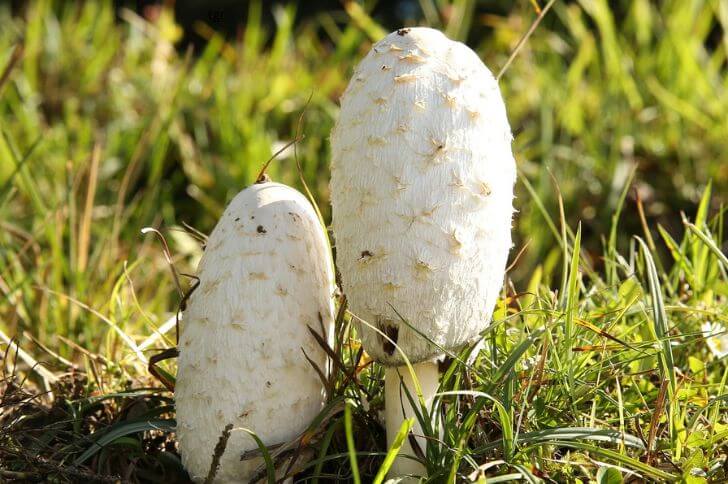
Shaggy Mane mushrooms are one of the most common mushrooms in IA. Also called Coprinus comatus, these edible fungi are in abundance in fall (August to late November) .
Identification:
They are easily identified by their unique appearance; the mushroom caps start out white and conical in shape before quickly turning into a shaggy mass of black fibers. As they mature, their gills dissolve from bottom to top and release a black liquid that is said to look like ink.
These types of mushrooms can be found growing on lawns, pastures, meadows and roadsides.
Can you eat shaggy manes? Yes, but I’d recommend you don’t unless you just want to try them out. There are better and tastier fall Iowa mushrooms like king boletes or morels.
15. Common Eastern Black Morel
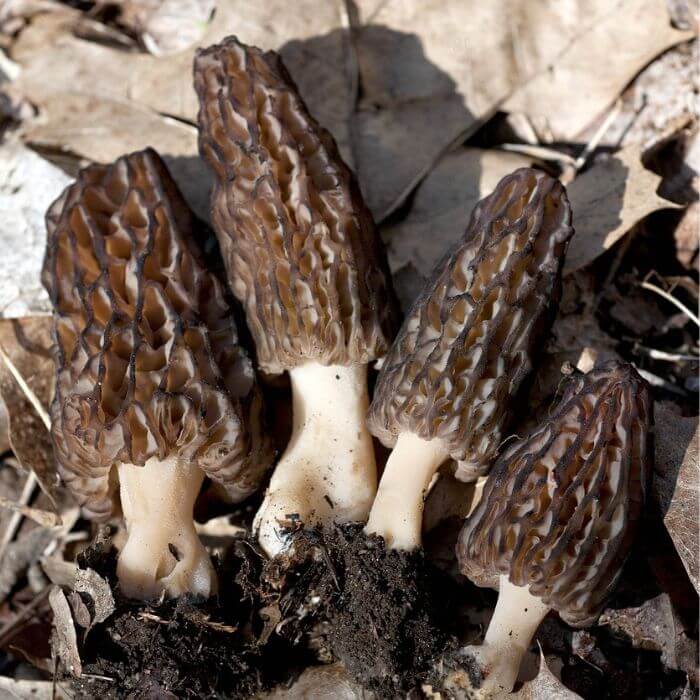
The Common Eastern Black Morel mushroom is a prized delicacy among mushroom Hawkeyes foragers and mycologists alike. It is a member of the Morchella genus, related to the yellow morel and white morel mushrooms.
Identification:
The common eastern black morel has an unmistakable appearance, with its light gray to black color with ridges on their surface that look like honeycomb cells
They will typically have a two-to four-inch tall cap that is shaped like an inverted cone or bell.Their steps are really short. Once cut open lengthwise, the inside of these mushrooms will be hollow.
When can you hunt for common eastern black morels in Iowa? These are spring mushrooms and they grow in well-drained soil.
16. King Bolete
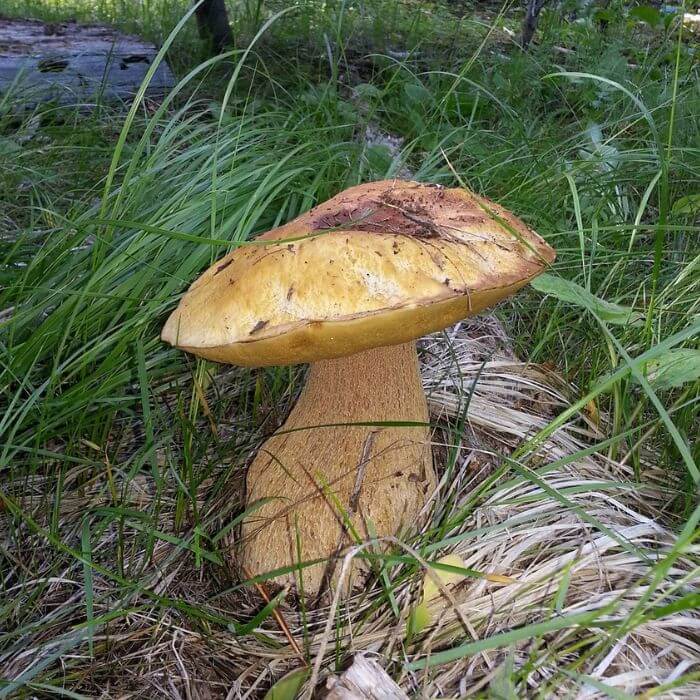
Another Iowa fall mushroom that has foragers excited is the King bolete. Also called porcini or pen, it grows individually or in small clusters near oaks in North America and pines in Europe.
Identification:
It is recognized by its large brown cap with a smooth top surface and whitish-yellow pores located under their cap. This type of mushroom has a thick, white or cream-colored stalk that can reach up to 10 inches long.
Along with identifying them and knowing where they grow, you need to learn when to look for them in Iowa.
They start popping in early August and last through mid-October. After a strong rain, check your patches after a two or three days and harvest when young.
Inedible Mushrooms of Iowa
17. Carolina False Morel
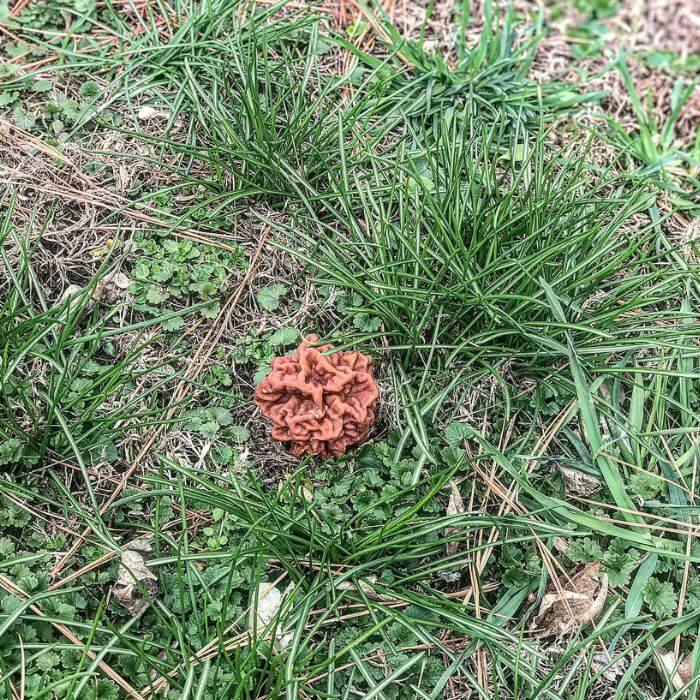
Carolina false morels are a type of inedible mushroom in Iowa. Knowing how to identify this morel is essential for any mushroom hunter, as it can easily be mistaken for an edible mushroom due to its similar appearance.
Identification:
Generally they are reddish-brown with a deeply wrinkled surface that is attached to a long stem. The caps may appear lumpy similar to ‘brain-like’ structures.
When cut open, it has whitish flesh that looks like cauliflower. Note that true morels are hollow. Additionally Carolina morels are heavier compared to true morels. These are spring mushrooms.
18. Artist’s Conk
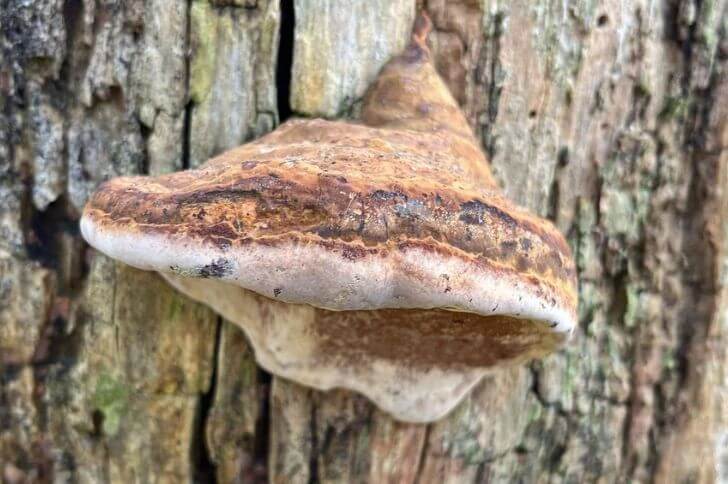
source: culverwell_ringing
Artist’s conk mushrooms, scientifically called Ganoderma applanatum, are bracket fungi with a hard, white to dark brown layered cap.
These mushrooms can be found growing on the bark of hardwood trees throughout the year. Artist’s conks are not edible. But, they can be ground to make tea .
19. False Parasol
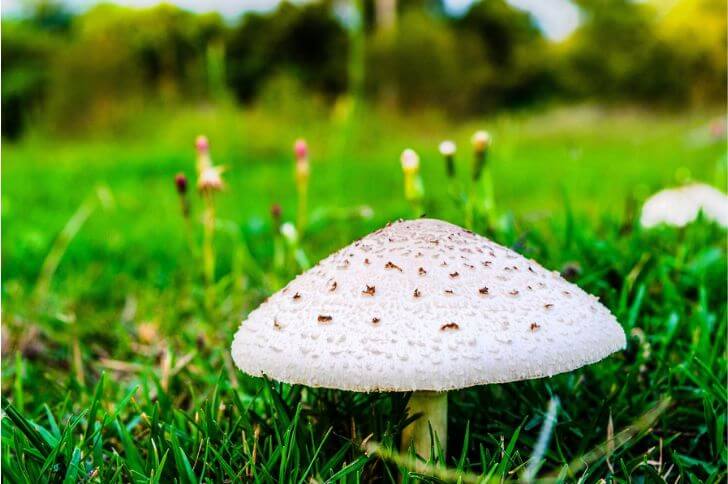
Another summer to fall mushroom you should avoid is the false parasol. Also called green-spored lepiota, they occur from mid June to early September.
Identification:
This mushroom has an appearance similar to that of the edible parasol mushroom, but is more commonly found in urban and suburban areas.
False parasol mushrooms have a distinctive white cap with brownish scales and a brown center. The stem is thin and long. Note, the brown scale may be washed off by rain.
Their gills are whitish for younger fungi and turn grayish-green as they mature. In addition to its distinct look, they have a gray-green spore print and no distinctive smell.
FAQs
What types of mushrooms grow in Iowa?
Common mushrooms of Iowa include morels, golden oysters, king boletes, shaggy manes, hedgehogs, chicken of the woods, hen of the woods and chanterelles.
What mushrooms are inedible in Iowa?
When foraging in Iowa you should avoid false parasols, Carolina false morels, torn fibercap, earthballs and jack-o-lanterns.
Final Thoughts
In conclusion,the variety of mushrooms in Iowa is truly remarkable. Hundreds of species of gilled and spored mushrooms can be found across the state.
Mushrooms are an important part of Iowa’s natural ecosystem, providing food for foragers and adding color to the landscape.
From chanterelles to golden oysters to morels, Iowa has so much to offer for those looking for a culinary adventure.
Not only are mushrooms abundant in Iowa’s grasslands, forests, and agricultural spaces, but they are also easy to identify and pick with the help of the above mushroom identification guide.
Sources:
Hi There,
My name is Jenny. I’m the Chief Editor at Try Green Recipes and besides making yummy and healthy foods for my kids, grandkids, and friends. I’m new to the blogging world but I believe what I have to share is unique and will bring joy to your home. If you are adventurous and want try something tasty, let’s get started.

